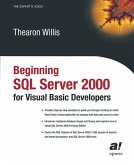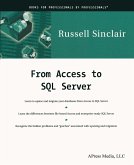This book takes an in-depth, practical look at the process of designing and building efficient relational databases. It is a book of two halves. The first covers the logical design of databases, and the second looks at the physical design and implementation on SQL Server 2000.
Whereas many texts on this topic are rather dry and theoretical, this books considers design issues from a "real world" point of view. It covers the process of implementing a database using Microsoft SQL Server 2000 from the point where someone mentions to you that they want a database, all the way through to generating tables and implementing access to these tables. It provides a full and realistic case study that clearly illustrates the full process, from initial discussions of a client's needs, through development of a logical model, to a full implementation of the system.
Database design is one of the most contentious issues in computer science. There is always a delicate balance to be struck between the strict academic rules that govern the design of relational databases and the real-world techniques that programmers apply to get the job done in a certain time frame. This book's goal is to coverfrom a "real-world" point of viewall of the essential elements in designing, modeling, and building efficient relational databases, while avoiding a dry, theoretical approach.
Author Louis Davidson explains the process of implementing a database-from generating tables and allowing access to these tables using Microsoft SQL Server 2000. This includes tackling data modeling (focusing on the IDEF1X notation), requirements gathering, normalization (beyond the Third Normal Form), and implementing tables, constraints, triggers, procedures, user-defined functions, and so on. Davidson provides a full and realistic case study that clearly illustrates the entire process, from the initial discussions of a client's needs, through development of a logical model, to a complete implementation of the system.
Whereas many texts on this topic are rather dry and theoretical, this books considers design issues from a "real world" point of view. It covers the process of implementing a database using Microsoft SQL Server 2000 from the point where someone mentions to you that they want a database, all the way through to generating tables and implementing access to these tables. It provides a full and realistic case study that clearly illustrates the full process, from initial discussions of a client's needs, through development of a logical model, to a full implementation of the system.
Database design is one of the most contentious issues in computer science. There is always a delicate balance to be struck between the strict academic rules that govern the design of relational databases and the real-world techniques that programmers apply to get the job done in a certain time frame. This book's goal is to coverfrom a "real-world" point of viewall of the essential elements in designing, modeling, and building efficient relational databases, while avoiding a dry, theoretical approach.
Author Louis Davidson explains the process of implementing a database-from generating tables and allowing access to these tables using Microsoft SQL Server 2000. This includes tackling data modeling (focusing on the IDEF1X notation), requirements gathering, normalization (beyond the Third Normal Form), and implementing tables, constraints, triggers, procedures, user-defined functions, and so on. Davidson provides a full and realistic case study that clearly illustrates the entire process, from the initial discussions of a client's needs, through development of a logical model, to a complete implementation of the system.









